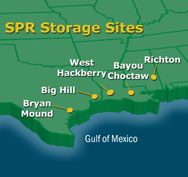|
|

|
 |
|
Due to elevated security concerns, detailed information on SPR sites has been removed from this web site. | | Emergency crude oil is stored in the Strategic Petroleum Reserve in salt caverns. Created deep within the massive salt deposits that underlie most of the Texas and Louisiana coastline, the caverns offer the best security and are the most affordable means of storage, costing up to 10 times less than aboveground tanks and 20 times less than hard rock mines.
Storage locations along the Gulf Coast were selected because they provide the most flexible means for connecting to the Nation's commercial oil transport network. Strategic Reserve oil can be distributed through interstate pipelines to nearly half of the Nation's oil refineries or loaded into ships or barges for transport to other refineries.
Strategic Petroleum Reserve caverns range in size from 6 to 35 million barrels in capacity; a typical cavern holds 10 million barrels and cylindrical in shape with a diameter of 200 feet and a height of 2,000 feet. One storage cavern is large enough for Chicago's Sears Tower to fit inside with room to spare. The Reserve contains 62 of these huge underground caverns.
How the SPR Storage Sites Were Created
Salt caverns along the Gulf Coast have been used for storage for many years by the petrochemical industry. When the U.S. Government decided to create the Strategic Petroleum Reserve in the mid-1970s, it acquired previously created salt caverns to store the first 250 million barrels of crude oil. This was the most rapid way to begin securing an emergency supply of crude oil following the oil shocks of the 1970s. To stockpile oil beyond the first 250 million barrels, the Department of Energy created additional caverns.
Salt caverns are carved out of underground salt domes by a process called "solution mining." Essentially, the process involves drilling a well into a salt formation, then injecting massive amounts of fresh water. The water dissolves the salt. In creating the SPR caverns, the dissolved salt was removed as brine and either reinjected into disposal wells or more commonly, piped several miles offshore into the Gulf of Mexico. By carefully controlling the freshwater injection process, salt caverns of very precise dimensions can be created. For every barrel of crude oil to be stored in the SPR's salt caverns, it took 7 barrels of water to create the storage space.
Besides being the lowest cost way to store oil for long periods of time, the use of deep salt caverns is also one of the most environmentally secure. At depths ranging from 2000 to 4000 feet, the salt walls of the storage caverns are "self-healing." The extreme geologic pressures make the salt walls rock hard, and should any cracks develop in the walls, they would be almost instantly closed.
An added benefit of deep salt cavern storage is the natural temperature difference between the top of the caverns and the bottom, a distance of around 2,000 feet. The temperature differential keeps the crude oil continuously circulating in the caverns, maintaining the oil at a consistent quality.
The fact that oil floats on water is the underlying mechanism used to move oil in and out of the SPR caverns. To withdraw crude oil, fresh water is pumped into the bottom of a cavern. The water displaces the crude oil to the surface. After the oil is removed from the SPR caverns, pipelines send it to various terminals and refineries around the nation.
|
 |
 |
 |
PROGRAM CONTACTS
 |
> |
David Johnson
Office of Fossil Energy
(FE-40)
U.S. Department of Energy
Washington, DC 20585
202-586-4410 |

|
|